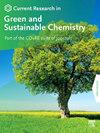Comparison of the performance of various forms of nano carbon as a membrane with the aim of optimal use in water purification and providing a mathematical model to predict membrane behavior
Q2 Materials Science
Current Research in Green and Sustainable Chemistry
Pub Date : 2025-01-01
DOI:10.1016/j.crgsc.2025.100472
引用次数: 0
Abstract
The growing global population and the provision of safe drinking water have become a major challenge facing the world today. Water shortages are felt in various uses such as drinking, industry, and agriculture, and the need for water consumption is expected to double in the next 25 years according to forecasts. One way to meet the need for water consumption is to use saline water from wells, wastewater, and their treatment. In this study, using laboratory studies, the clogging of various types of nano-membranes including different forms of carbon such as single and multi-walled carbon nanotubes, carbon nanofibers and fullerene (C60) which are used in the water purification process is investigated. Experimental results show that the use of a membrane made with multi-walled carbon nanotubes performs better compared to other forms of carbon and therefore has a more favorable performance in reducing the hardness of the effluent. Experimental results show that the total hardness of the treated water when using a membrane made with multi-walled carbon nanotubes at a constant temperature of 23 °C and a mass of 10 g and a flow rate of 1.87 L per second after 10 days is equal to 210 micro mhos per centimeter. The significance of this research lies in its comprehensive comparison of various carbon-based nano-membranes for water purification and the development of a predictive mathematical model for membrane fouling behavior. By identifying multi-walled carbon nanotubes as the optimal material with superior performance, longevity, and reusability, this study offers a promising solution for enhancing the efficiency and sustainability of membrane-based desalination systems. The findings contribute to addressing the global challenge of water scarcity by advancing nanotechnology applications in environmental engineering.
比较不同形式的纳米碳作为膜的性能,以优化其在水净化中的应用,并提供预测膜行为的数学模型
日益增长的全球人口和提供安全饮用水已成为当今世界面临的主要挑战。饮用水、工业和农业等各种用途都感到缺水,据预测,未来25年用水量将增加一倍。满足用水需求的一种方法是使用井中的盐水、废水及其处理。在本研究中,通过实验室研究,研究了水净化过程中使用的各种类型的纳米膜的堵塞情况,包括不同形式的碳,如单壁碳纳米管和多壁碳纳米管,碳纳米纤维和富勒烯(C60)。实验结果表明,与其他形式的碳相比,使用多壁碳纳米管制成的膜性能更好,因此在降低出水硬度方面具有更有利的性能。实验结果表明,在温度为23℃、质量为10 g、流速为1.87 L / s的条件下,多壁碳纳米管膜处理后的水在10天后的总硬度为210微mhos / cm。本研究的意义在于对各种碳基纳米水净化膜进行了综合比较,并建立了膜污染行为的预测数学模型。通过确定多壁碳纳米管是性能优越、寿命长、可重复使用的最佳材料,本研究为提高膜基海水淡化系统的效率和可持续性提供了一个有前途的解决方案。这些发现通过推进纳米技术在环境工程中的应用,有助于解决水资源短缺的全球挑战。
本文章由计算机程序翻译,如有差异,请以英文原文为准。
求助全文
约1分钟内获得全文
求助全文
来源期刊

Current Research in Green and Sustainable Chemistry
Materials Science-Materials Chemistry
CiteScore
11.20
自引率
0.00%
发文量
116
审稿时长
78 days
 求助内容:
求助内容: 应助结果提醒方式:
应助结果提醒方式:


